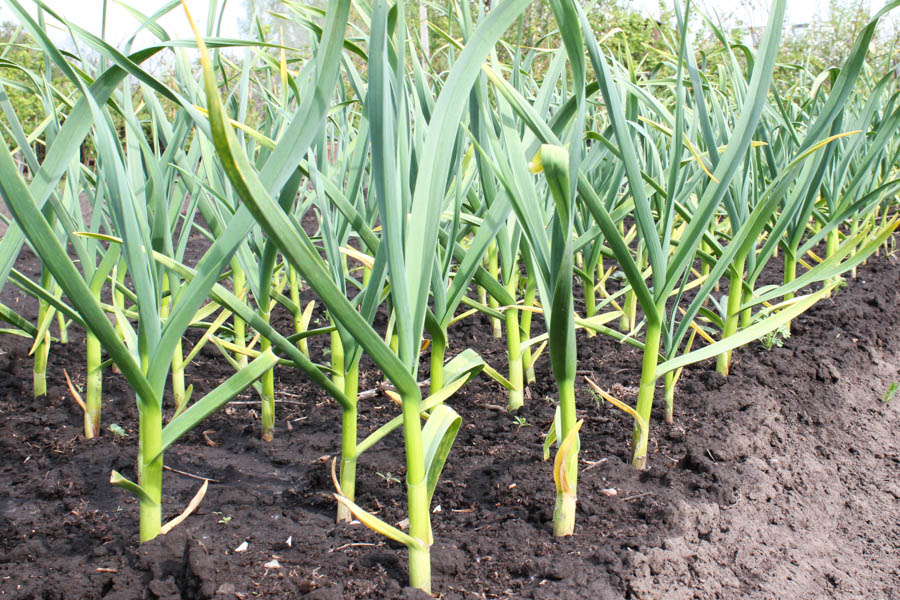Watering Tips for Softneck Garden Garlic

GardenZeus receives commissions for purchases made through links in this post.
Garlic performs best in fertile soil with good drainage. Overwatering and underwatering garlic both result in stressed plants, poor bulb formation, and increased pest-and-disease problems. Water may pool below the soil surface or in compacted areas underground, with poor drainage sometimes becoming problematic even when the soil surface is dry.
Ideally garlic plants should be watered to the full depth of their roots and soil should stay evenly moist but not wet, especially during the first few months in the ground after cloves begin to grow. This can be more difficult to accomplish than it sounds. See Growing Garlic in the California Home Garden for important planting tips that may make or break your success with garden garlic. Soil can appear dry at the surface but be wet or even waterlogged to the point of being anaerobic starting just an inch or two below; or alternately, appear wet at the surface but without sufficient moisture at the level of garlic roots.
Evaluate water penetration and moisture in the top few inches of soil by pressing a long screwdriver or thin metal rod into soil both after watering or when soil is wet, and when the soil surface is dry. Soil resistance changes as dry soil is reached. If soil resistance lessens after the first inch or two, this may indicate wet soil beneath the surface. Alternatively, consider using a soil moisture meter to evaluate the moisture level.
The best method for watering garlic is generally drip irrigation, especially in heavy soils, which allows for infiltration of water over time. Consider installing drip irrigation before planting, which can save hassle and damage to plants later on.
The winter growing season is also the rainy season for most of California. Garlic is prone to disease during prolonged periods of rain when planted in any soil that lacks good drainage. The best solution for many gardeners and in most heavy and/or uncultivated soils is to plant garlic in raised beds that are at least 8-12 inches deep, with loose, fertile soil that holds moisture but drains well during winter rains.
Garlic generally doesn’t need watering during rainy periods and for a few days to a week or longer after rain. Rain alone is usually not sufficient in most California areas to grow garlic. Steady or heavy rainfall may reduce or eliminate the need for watering garlic for periods of a week or two after rain stops, sometimes longer depending upon temperatures and soil texture.
Garlic needs regular watering. What this means varies depending upon temperature, maturity of the garlic plants, soil texture, and rainfall. In average soils, garlic needs about 16 inches of total water during a growing season, or about 1/2-inch-to-1-inch of water per week, with more water during warm weather and rapid growth, and less water during cold weather, as cloves are first sprouting, and for 2-4 weeks before harvest.
In heavy or clay soils, garlic may need watering once per week when cloves are small during cool or cold weather, or two to four times per week during warm-to-hot weather. In heavy or clay soils, established plants may need watering only once every week or two during cool or cold weather, or once or twice per week during warm-to-hot weather. Garlic may need more-frequent watering in light and sandy soils, in new soils such as in raised beds, or in any soils that drain or dry out quickly.
Compacted soils may shunt water sideways at the surface, and water might not infiltrate to the full depth of the garlic bulbs. This can be especially problematic in heavy soils that become recompacted a few months after garlic was planted. If your soil becomes compacted, test water infiltration using the screwdriver method described above.
Minimize watering garlic for about 2-4 weeks before harvest. For best-quality bulbs, stop watering entirely when plants are nearing harvest and the lowest leaves turn yellow or brown. This usually begins a few weeks before bulbs are fully mature and ready to harvest.
Don’t know your GardenZeus climate zone? Click here.
For more information about growing garlic:
Growing Garlic in the California Home Garden
Garlic Care and Maintenance in the California Home Garden